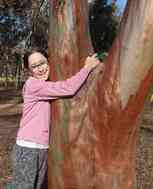Foxes Lair Arboretum
 Everyone should hug a tree
Everyone should hug a tree
The arboretum was planted by the state forestry department in the 1950's and 1960's to show which trees were suited to this area for replanting unproductive areas.
The area also has a picnic spot, the Granite walk trail and shared cycle trails. A car park at Range Road provides access to wheelchair users, and a parking spot for the Griffo mountain bike circuit.
The arboretum contains over 60 species of eucalypts, which display the diversity of this iconic Australian species, and a few species of pine.
The scavenger hunt at the arboretum is a fun way to learn more there. Download and print the sheet before visiting.
The files below give you an insight into this unique genera, and enable you to identify them in the arboretum.
The area also has a picnic spot, the Granite walk trail and shared cycle trails. A car park at Range Road provides access to wheelchair users, and a parking spot for the Griffo mountain bike circuit.
The arboretum contains over 60 species of eucalypts, which display the diversity of this iconic Australian species, and a few species of pine.
The scavenger hunt at the arboretum is a fun way to learn more there. Download and print the sheet before visiting.
The files below give you an insight into this unique genera, and enable you to identify them in the arboretum.
|
| ||||||||||||
Eucalyptus is a Greek word meaning ‘well covered’ because eucalypt flowers uniquely have an operculum (bud cap) instead of petals and sepals.
They also have woody fruit ('gum nuts'), and many have oil glands, which give these plants their characteristic smell when crushed.
Eucalypts have three growth types
1. Tree - single trunk, with branches that usually start more than1 metre above the ground and occupy about half of the tree’s height. If the main trunk is damaged, many branches can resprout from the base or stems (epicormic growth). Examples include salmon and York gums, wandoo, marri and jarrah.
2. Mallet - single trunk with relatively steep angled branches and a terminal crown. Mallets are sensitive to fire and do not recover if the main trunk is lost. Examples include brown, blue, and silver mallets, yates, gimlet and moort. Mallets often occur as pure or massed stands.
3. Mallee - multi stemmed plants usually less than 10 metres high Several stems come from a lignotuber ('mallee root') that can replace them when one or more are lost. Mallees that have not had to regenerate may have a single stem. an example is the Merredin Mallee
A great many eucalypts draw on deep reserves of soil water to flower in late spring and summer. This sustains a huge population of nectar/pollen eating animals over summer, which is essential for maintaining crop and bush diversity. Just think, if we didn’t have them there would be no European honey bees – no honey or fruit industry or crops like canola
The arboretum is a great place to walk early mornings and evenings to see the great variation in flower colour and shape, leaf shape texture and sheen, and new bark growth.
They also have woody fruit ('gum nuts'), and many have oil glands, which give these plants their characteristic smell when crushed.
Eucalypts have three growth types
1. Tree - single trunk, with branches that usually start more than1 metre above the ground and occupy about half of the tree’s height. If the main trunk is damaged, many branches can resprout from the base or stems (epicormic growth). Examples include salmon and York gums, wandoo, marri and jarrah.
2. Mallet - single trunk with relatively steep angled branches and a terminal crown. Mallets are sensitive to fire and do not recover if the main trunk is lost. Examples include brown, blue, and silver mallets, yates, gimlet and moort. Mallets often occur as pure or massed stands.
3. Mallee - multi stemmed plants usually less than 10 metres high Several stems come from a lignotuber ('mallee root') that can replace them when one or more are lost. Mallees that have not had to regenerate may have a single stem. an example is the Merredin Mallee
A great many eucalypts draw on deep reserves of soil water to flower in late spring and summer. This sustains a huge population of nectar/pollen eating animals over summer, which is essential for maintaining crop and bush diversity. Just think, if we didn’t have them there would be no European honey bees – no honey or fruit industry or crops like canola
The arboretum is a great place to walk early mornings and evenings to see the great variation in flower colour and shape, leaf shape texture and sheen, and new bark growth.